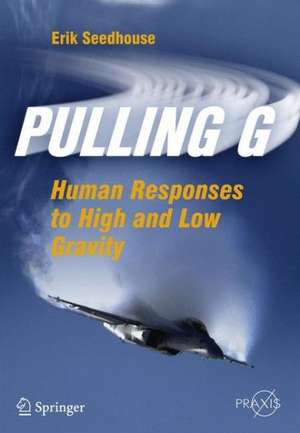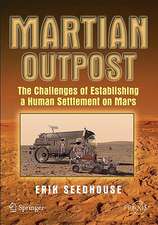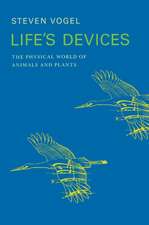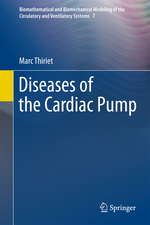Pulling G: Human Responses to High and Low Gravity: Springer Praxis Books
Autor Erik Seedhouseen Limba Engleză Paperback – 24 sep 2012
Erik Seedhouse is eminently qualified to describe the effects of large accelerations on the body. In addition to being the author of several previously published Springer Praxis books, he has developed astronaut-training protocols and is the training director for Astronauts for Hire (A4H). He is also the Canadian Forces’ High Risk Acceleration Training Officer.
Din seria Springer Praxis Books
-
 Preț: 294.46 lei
Preț: 294.46 lei -
 Preț: 223.45 lei
Preț: 223.45 lei -
 Preț: 193.12 lei
Preț: 193.12 lei -
 Preț: 167.85 lei
Preț: 167.85 lei -
 Preț: 288.98 lei
Preț: 288.98 lei -
 Preț: 323.74 lei
Preț: 323.74 lei -
 Preț: 401.38 lei
Preț: 401.38 lei -
 Preț: 264.12 lei
Preț: 264.12 lei - 8%
 Preț: 513.00 lei
Preț: 513.00 lei -
 Preț: 190.01 lei
Preț: 190.01 lei -
 Preț: 218.16 lei
Preț: 218.16 lei -
 Preț: 312.06 lei
Preț: 312.06 lei - 17%
 Preț: 414.05 lei
Preț: 414.05 lei -
 Preț: 216.41 lei
Preț: 216.41 lei -
 Preț: 262.27 lei
Preț: 262.27 lei -
 Preț: 264.35 lei
Preț: 264.35 lei -
 Preț: 167.63 lei
Preț: 167.63 lei -
 Preț: 284.81 lei
Preț: 284.81 lei -
 Preț: 259.08 lei
Preț: 259.08 lei -
 Preț: 305.47 lei
Preț: 305.47 lei -
 Preț: 244.14 lei
Preț: 244.14 lei -
 Preț: 227.85 lei
Preț: 227.85 lei -
 Preț: 285.25 lei
Preț: 285.25 lei -
 Preț: 295.56 lei
Preț: 295.56 lei -
 Preț: 357.17 lei
Preț: 357.17 lei -
 Preț: 275.79 lei
Preț: 275.79 lei -
 Preț: 257.08 lei
Preț: 257.08 lei -
 Preț: 349.71 lei
Preț: 349.71 lei -
 Preț: 272.45 lei
Preț: 272.45 lei -
 Preț: 270.27 lei
Preț: 270.27 lei - 8%
 Preț: 456.51 lei
Preț: 456.51 lei -
 Preț: 352.34 lei
Preț: 352.34 lei - 8%
 Preț: 394.80 lei
Preț: 394.80 lei -
 Preț: 320.65 lei
Preț: 320.65 lei -
 Preț: 325.29 lei
Preț: 325.29 lei -
 Preț: 253.11 lei
Preț: 253.11 lei -
 Preț: 192.86 lei
Preț: 192.86 lei -
 Preț: 313.40 lei
Preț: 313.40 lei -
 Preț: 150.51 lei
Preț: 150.51 lei -
 Preț: 233.34 lei
Preț: 233.34 lei -
 Preț: 286.78 lei
Preț: 286.78 lei -
 Preț: 212.01 lei
Preț: 212.01 lei -
 Preț: 366.83 lei
Preț: 366.83 lei -
 Preț: 299.99 lei
Preț: 299.99 lei -
 Preț: 232.27 lei
Preț: 232.27 lei -
 Preț: 284.58 lei
Preț: 284.58 lei -
 Preț: 212.45 lei
Preț: 212.45 lei -
 Preț: 159.81 lei
Preț: 159.81 lei -
 Preț: 349.48 lei
Preț: 349.48 lei - 20%
 Preț: 2061.64 lei
Preț: 2061.64 lei
Preț: 216.41 lei
Nou
Puncte Express: 325
Preț estimativ în valută:
41.42€ • 43.08$ • 34.19£
41.42€ • 43.08$ • 34.19£
Carte disponibilă
Livrare economică 24 martie-07 aprilie
Preluare comenzi: 021 569.72.76
Specificații
ISBN-13: 9781461430292
ISBN-10: 1461430291
Pagini: 236
Ilustrații: XXVI, 210 p. 106 illus., 95 illus. in color.
Dimensiuni: 168 x 240 x 12 mm
Greutate: 0.5 kg
Ediția:2012
Editura: Springer
Colecția Springer
Seriile Springer Praxis Books, Popular Science
Locul publicării:New York, NY, United States
ISBN-10: 1461430291
Pagini: 236
Ilustrații: XXVI, 210 p. 106 illus., 95 illus. in color.
Dimensiuni: 168 x 240 x 12 mm
Greutate: 0.5 kg
Ediția:2012
Editura: Springer
Colecția Springer
Seriile Springer Praxis Books, Popular Science
Locul publicării:New York, NY, United States
Public țintă
Popular/generalCuprins
Preface.- Acknowledgments.- About the Author.- List of figures.- List of tables.- List of abbreviations and acronyms.- Chapter 1: Project MX981.- Chapter 2: To black out or not to black out.- Chapter 3: The wobblies.- Chapter 4: The G machine.- Chapter 5: Formula One.- Chapter 6: Punching out.- Chapter 7: Launch and re-entry.- Chapter 8: Microgravity.- Chapter 9: Artificial gravity.- Index.
Notă biografică
Erik Seedhouse is a Norwegian-Canadian suborbital astronaut whose life-long ambition is to work in space. After completing his first degree in Sports Science at Northumbria University, the author joined the legendary 2nd Battalion the Parachute Regiment, the world's most elite airborne regiment. During his time in the "Para's," Erik spent six months in Belize, where he was trained in the art of jungle warfare. Later, he spent several months learning the intricacies of desert warfare on the Akamas Range in Cyprus. He made more than 30 jumps from a Hercules C130 aircraft, performed more than 200 abseils from a helicopter, and fired more light anti-tank weapons than he cares to remember!
Upon returning to the comparatively mundane world of academia, the author embarked upon a master's degree in Medical Science at Sheffield University. He supported his studies by winning prize money in 100-km running races. After placing third in the World 100-km Championships in 1992 and setting the North American 100-km record, the author turned to ultradistance triathlon, winning the World Endurance Triathlon Championships in 1995 and 1996. For good measure, he also won the inaugural World Double Ironman Championships in 1995 and the infamous Decatriathlon, an event requiring competitors to swim 38 km, cycle 1,800 km, and run 422 km. Non-stop!
Returning to academia in 1996, Erik pursued his Ph.D. at the German Space Agency's Institute for Space Medicine. While conducting his Ph.D. studies, he still found time to win Ultraman Hawaii and the European Ultraman Championships as well as completing the Race Across America bike race. Due to his success as the world's leading ultradistance triathlete, Erik was featured in dozens of magazines and television interviews. In 1997, GQ magazine nominated him as the "Fittest Man in the World."
In 1999, Erik decided it was time to get a real job. He retired from being a professional triathlete and started his post-doctoral studies at Vancouver's Simon Fraser University's School of Kinesiology. In 2995, the author worked as an astronaut training consultant for Bigelow Aerospace and wrote Tourists in Space, a training manual for spaceflight participants. He is a Fellow of the British Interplanetary Society and a member of the Space Medical Association. Recently, he was one of the final 30 candidates in the Canadian Space Agency's Astronaut Recruitment Campaign. Erik works as a manned spaceflight consultant, professional speaker, triathlon coach, and author. He is the Training Director for Astronauts for Hire (www.astronauts4hire.org) and completed his suborbital astronaut training in May 2011. He is also Canada's only High Risk Acceleration Training Officer, which is a long-winded way of saying he spins people in Canada's centrifuge.
In addition to being a suborbital astronaut, triathlete, sky-diver, pilot, and author, Erik is an avid mountaineer and is currently pursuing his goal of climbing the Seven Summits. Pulling G is his tenth book. When not writing, he spends as much free time as possible in Kona on the Big Island of Hawaii and at his real home in Sandefjord, Norway. Erik and his wife, Doina, are owned by three rambunctious cats - Jasper, Mini-Mach, and Lava - none of whom has expressed any desire to travel into space but who nevertheless provided invaluable assistant in writing this book (!).
Upon returning to the comparatively mundane world of academia, the author embarked upon a master's degree in Medical Science at Sheffield University. He supported his studies by winning prize money in 100-km running races. After placing third in the World 100-km Championships in 1992 and setting the North American 100-km record, the author turned to ultradistance triathlon, winning the World Endurance Triathlon Championships in 1995 and 1996. For good measure, he also won the inaugural World Double Ironman Championships in 1995 and the infamous Decatriathlon, an event requiring competitors to swim 38 km, cycle 1,800 km, and run 422 km. Non-stop!
Returning to academia in 1996, Erik pursued his Ph.D. at the German Space Agency's Institute for Space Medicine. While conducting his Ph.D. studies, he still found time to win Ultraman Hawaii and the European Ultraman Championships as well as completing the Race Across America bike race. Due to his success as the world's leading ultradistance triathlete, Erik was featured in dozens of magazines and television interviews. In 1997, GQ magazine nominated him as the "Fittest Man in the World."
In 1999, Erik decided it was time to get a real job. He retired from being a professional triathlete and started his post-doctoral studies at Vancouver's Simon Fraser University's School of Kinesiology. In 2995, the author worked as an astronaut training consultant for Bigelow Aerospace and wrote Tourists in Space, a training manual for spaceflight participants. He is a Fellow of the British Interplanetary Society and a member of the Space Medical Association. Recently, he was one of the final 30 candidates in the Canadian Space Agency's Astronaut Recruitment Campaign. Erik works as a manned spaceflight consultant, professional speaker, triathlon coach, and author. He is the Training Director for Astronauts for Hire (www.astronauts4hire.org) and completed his suborbital astronaut training in May 2011. He is also Canada's only High Risk Acceleration Training Officer, which is a long-winded way of saying he spins people in Canada's centrifuge.
In addition to being a suborbital astronaut, triathlete, sky-diver, pilot, and author, Erik is an avid mountaineer and is currently pursuing his goal of climbing the Seven Summits. Pulling G is his tenth book. When not writing, he spends as much free time as possible in Kona on the Big Island of Hawaii and at his real home in Sandefjord, Norway. Erik and his wife, Doina, are owned by three rambunctious cats - Jasper, Mini-Mach, and Lava - none of whom has expressed any desire to travel into space but who nevertheless provided invaluable assistant in writing this book (!).
Textul de pe ultima copertă
Formula 1 racing drivers, figher pilots, astronauts - G forces are an integral part of their lives
- How do racing drivers sustain high G loads and not pass out?
- What accelerative forces are unleashed when a fighter pilot ejects from a high-performance jet?
- What is it like being launched into space and what are the effects on astronauts living in zero G on board the International Space Station?
- How do aircraft simulate zero G?
Pulling G gives a unique insight into how G forces affect people working inthe high and low G environments. It examines the risks of high and low acceleration and explains the physiology of surviving in these environments. The history of G-related research is described, together with present-day and future development of methods to cope with the effects of increased and reduced G.
- How do racing drivers sustain high G loads and not pass out?
- What accelerative forces are unleashed when a fighter pilot ejects from a high-performance jet?
- What is it like being launched into space and what are the effects on astronauts living in zero G on board the International Space Station?
- How do aircraft simulate zero G?
Pulling G gives a unique insight into how G forces affect people working inthe high and low G environments. It examines the risks of high and low acceleration and explains the physiology of surviving in these environments. The history of G-related research is described, together with present-day and future development of methods to cope with the effects of increased and reduced G.
Caracteristici
Explains the physiological and psychological effects of increased and decreased G on the human body Highlights the dangerous effects of changing gravitational environments, including common injuries in high acceleration environments Provides an overview of current gravity-related research



























